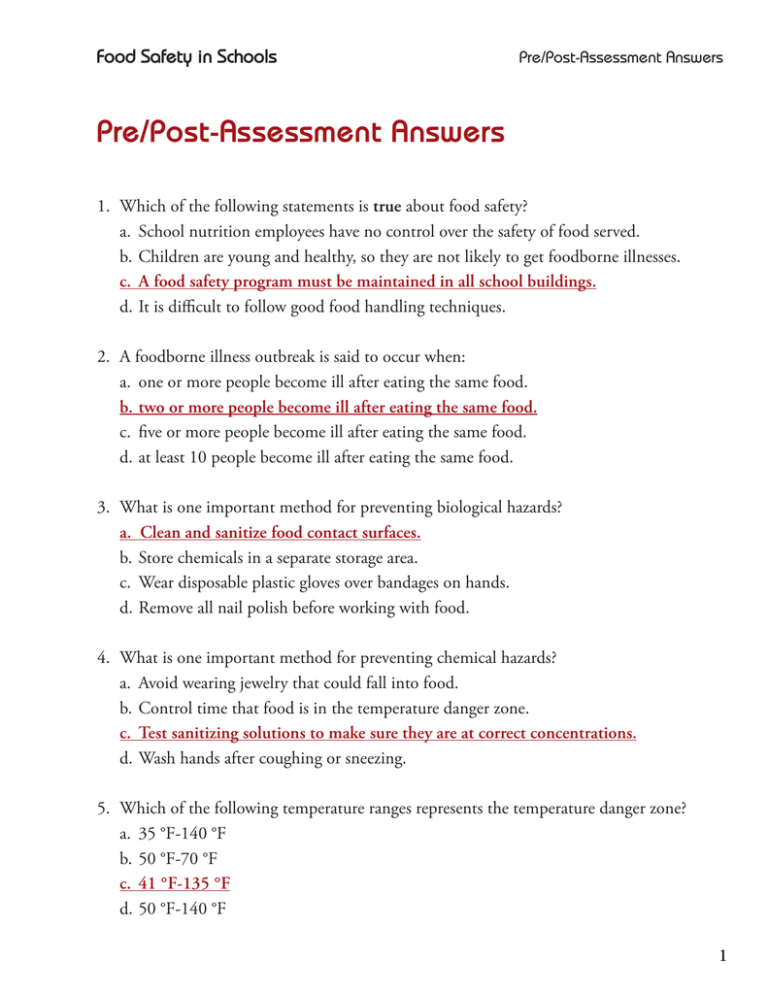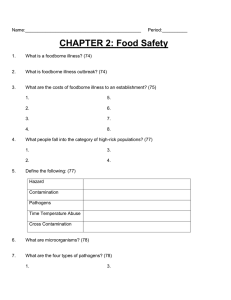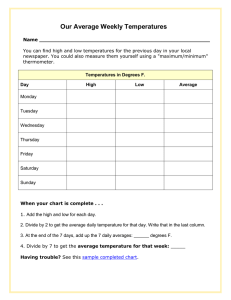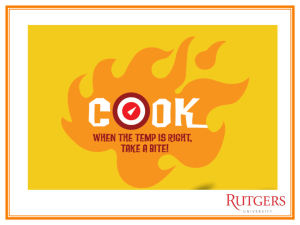Pre/Post-Assessment Answers
advertisement

Food Safety in Schools Pre/Post-Assessment Answers Pre/Post-Assessment Answers 1. Which of the following statements is true about food safety? a. School nutrition employees have no control over the safety of food served. b.Children are young and healthy, so they are not likely to get foodborne illnesses. c. A food safety program must be maintained in all school buildings. d.It is difficult to follow good food handling techniques. 2. A foodborne illness outbreak is said to occur when: a. one or more people become ill after eating the same food. b.two or more people become ill after eating the same food. c. five or more people become ill after eating the same food. d.at least 10 people become ill after eating the same food. 3. What is one important method for preventing biological hazards? a. Clean and sanitize food contact surfaces. b.Store chemicals in a separate storage area. c. Wear disposable plastic gloves over bandages on hands. d.Remove all nail polish before working with food. 4. What is one important method for preventing chemical hazards? a. Avoid wearing jewelry that could fall into food. b.Control time that food is in the temperature danger zone. c. Test sanitizing solutions to make sure they are at correct concentrations. d.Wash hands after coughing or sneezing. 5.Which of the following temperature ranges represents the temperature danger zone? a. 35 °F-140 °F b.50 °F-70 °F c. 41 °F-135 °F d.50 °F-140 °F 1 Pre/Post-Assessment Answers Food Safety in Schools 6. W hich of the following practices has been identified as a main cause of foodborne illnesses? a. Purchasing food from approved sources b.Using written Standard Operating Procedures c. Abusing the time-temperature relationship d.Checking temperatures of food during cooking 7. Cross contamination can occur when: a. ready-to-eat meats are stored on the top shelf in the refrigerator. b.hands are washed between tasks. c. color-coded cutting boards are used. d.a new can of peaches is added to leftover peaches and put on the salad bar. 8. How long should employees wash their hands? a. 8 seconds b.20 seconds c. 30 seconds d.40 seconds 9. Which of the following statements is true about taking food temperatures? a.A bimetallic stemmed thermometer may be used for taking temperatures of hamburger patties. b.Infrared thermometers can be used for taking cooking temperatures. c. Thermometers rarely need to be calibrated. d.Temperatures should be taken in multiple locations for foods such as casseroles. 10. Which of the following statements is true about thermometer calibration? a. Thermometers should be calibrated each time they are dropped. b. Thermometers should be calibrated at least monthly. c.Thermometers do not need to be calibrated because they are guaranteed to be accurate. d. Cold water calibration is the only acceptable method. 2 Food Safety in Schools Pre/Post-Assessment Answers 11. Bacteria that can be harmful are called: a. spoilage bacteria. b.pathogens. c.parasites. d.viruses. 12. Which of the following actions will kill harmful bacteria? a. Freezing the food for 4 hours b. Heating the food at a low temperature for a long time c. Keeping the food out of the temperature danger zone d. Cooking the food to the required internal temperature for 15 seconds 13. What is the most common cause of foodborne illness? a.Bacteria b.Mold c.Virus d.Yeast 14. Which bacteria could cause hemolytic uremic syndrome in young children? a. Campylobacter jejuni b. Shiga toxin-producing Escherichia coli (STEC) c. Listeria monocytogenes d. Staphylococcus aureus 15. If you observe mold on food, what recommendation should you follow? a. Cut away the moldy area and use the remainder of the food. b. Discard the food. c. Use the food in something that will be cooked. d. Use the food if the mold spots are small. 3 Pre/Post-Assessment Answers Food Safety in Schools 16.Which of the following practices supports pest infestation and growth in a school nutrition facility? a. Removing all cardboard boxes from the facility b. Cleaning grease traps often c. Storing food items on the floor d. Installing air doors at entrances 17.A three-compartment sink should be set up and used properly. Which statement is true about using a three-compartment sink? a. Set up compartments to wash, rinse, and sanitize. b. Set up compartments to rinse, wash, and sanitize. c. Prepare sanitizing solution daily. d. Use any water temperature for mixing detergent and sanitizer. 18. What type of thermometer can be used to test final rinse temperatures? a. Meat thermometer b. Self-adhering temperature sensing label c.Infrared d. Bi-metallic stemmed thermometer 19. When using a chemical dish machine, which of the following statements is true? a. Chemical solution concentrations are different than used for manual sanitizing. b. Sanitizing solution should be tested at the end of a rinse cycle. c.Testing of sanitizing solution is not necessary because the dish machine is serviced routinely. d. It is not necessary to document chemical sanitizer concentration. 20.Which one of the following provides important information about the safety of using a chemical? a. Standard Operating Procedures b. Training manual in school district c. Safety Data Sheet d. Cleaning schedules 4 Food Safety in Schools Pre/Post-Assessment Answers 21. Which of the following methods of thawing is acceptable? a. Place frozen food in the refrigerator on the bottom shelf. b. Place frozen food in room temperature water. c. Place frozen food in the refrigerator on the top shelf. d. Thaw frozen food in hot water, and then cook immediately. 22What is the recommended cooking temperature for a raw hamburger patty based on the Food Code? a. 135 °F b. 145 °F c. 155 °F d. 165 °F 23.What are the recommended holding temperatures for cold and hot foods based on the Food Code? a. 41 °F or below for cold foods, 135 °F or above for hot foods b. 45 °F or below for cold foods, 140 °F or above for hot foods c. 41 °F or below for cold foods, 140 °F or above for hot foods d. 45 °F or below for cold foods, 135 °F or above for hot foods 24. Which of the following statements is true about proper cooling of food? a. Plastic containers cool more quickly than stainless steel. b. Putting hot food immediately into a freezer is a best practice. c. Divide food into the smallest quantity possible before cooling. d. Using the two-step cooling method, total time is more important than temperature. 25. Which of the following statements is most true about reheating leftover foods? a. Reheat to 155 °F for 20 seconds. b. Reheat to 165 °F for 20 seconds within 1 hour. c. Reheat to 165 °F for 15 seconds. d. Reheat to 165 °F for 15 seconds within 2 hours. 5 Pre/Post-Assessment Answers Food Safety in Schools 26. Which statement is true about a food safety program based on HACCP principles? a. It is a proactive program to prevent foodborne illness. b. It is a reactive program developed to prevent foodborne illness. c. It is based on results of health department inspections. d. It is designed to be the responsibility of the district school nutrition director. 27.Which approach requires that school nutrition employees group menu items according to the number of times they go through the temperature danger zone? a. HACCP approach b. Process Approach c. Food safety approach d. Cooking approach 28. For no cook items, which steps require temperatures to be checked and recorded? a.Receiving b.Storing c. Cold holding d. All of the above 29. Menu items that go through the temperature danger zone 2-3 times are called: a. no cook items. b. same day service items. c. complex food preparation items. d. cooked items. 30. Menu items such as commercially prepared pizza and chicken nuggets would be categorized as: a. no cook items. b. same day service items. c. complex food preparation items. d. cooked items. 6


